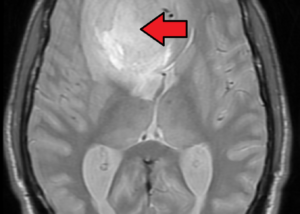
If you have pain in one eye when you move it, this can have many causes and unfortunately, two can be a brain tumor or an aneurysm.
This is one of those symptoms that, though usually brought on by a benign cause, a more serious cause needs to first be ruled out – as time is of the essence when we’re talking about a brain tumor or an aneurysm causing pain when you move one of your eyes.
More Likely Causes of Pain in One Eye with Movement
“Pain in one eye with movement indicates inflammation in or around the eye,” says Kaushal M. Kulkarni, MD, board certified ophthalmologist and neuro-ophthalmologist in private practice in New York.
“One of the most common causes of pain in one eye with movement is optic neuritis,” continues Dr. Kulkarni.
“Optic neuritis is typically associated with blurry vision or loss of vision in one eye (although it tends to affect both eyes in children).
“Sometimes, optic neuritis is associated with multiple sclerosis or other autoimmune conditions.
“Other causes of pain in one eye with eye movement can include inflammation of one or more eye muscles (orbital myositis), or infection or inflammation of the eye socket itself (orbital cellulitis or orbital inflammatory disease).”
Brain Tumor and Aneurysm
“Very rarely, a tumor behind the eye could cause pain in one eye with movement, although this would usually come on gradually and may also cause bulging of the eye socket (proptosis),” says Dr. Kulkarni.
Truth of the matter is, though a brain tumor can cause all sorts of things to go wrong with the eye, actual PAIN upon movement is exceedingly rare.
Here are the eye problems that a brain tumor is far more likely to cause:
• Bulging eye (as Dr. Kulkarni mentioned) or some kind of orbital displacement that the patient can detect.
• Drooping eyelid
• Eye movement: uncontrollable including one eye drifting inward (especially in adults)
• Inability to look upward
• Peripheral vision loss
• Pupils of obviously different size
• Vision loss (partial or complete)
• Vision changes: double, blurry
“An aneurysm could also cause pain in one eye with movement and may also cause an abnormal pupil on that side, eyelid drooping (ptosis) and/or double vision,” says Dr. Kulkarni.
This triad of unmatched pupil size, ptosis and double vision is STRONGLY indicative of an aneurysm!
There may not be any eye pain whatsoever with this classic triad, but it’s worth mentioning because most laypeople have no idea that this trio is highly suspicious for a brain aneurysm: a bulging blood vessel.
Get to the ER stat if you have these three symptoms. And have someone drive you.
“In summary, seek medical attention if you have pain in one eye with movement, especially if there are any other symptoms such as blurry vision, vision loss, double vision, eyelid drooping, redness in or around the eye, or bulging of the eye,” says Dr. Kulkarni.
Other symptoms that, when paired with eye pain are quite concerning, include excessive watering, a palpable lump along the side of the nose or near the inner corner of the eye, nasal congestion despite no cold, reduced sense of smell and unexplained nasal bleeding.
 Dr. Kulkarni has a special interest in optic nerve regeneration.
Dr. Kulkarni has a special interest in optic nerve regeneration.
 Lorra Garrick has been covering medical, fitness and cybersecurity topics for many years, having written thousands of articles for print magazines and websites, including as a ghostwriter. She’s also a former ACE-certified personal trainer.
Lorra Garrick has been covering medical, fitness and cybersecurity topics for many years, having written thousands of articles for print magazines and websites, including as a ghostwriter. She’s also a former ACE-certified personal trainer.
.









































